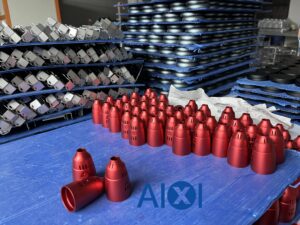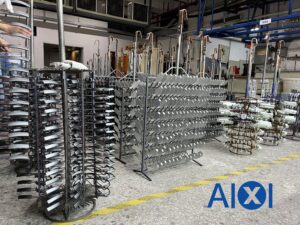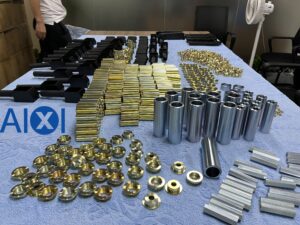As the economy develops and the consumption structure continues to upgrade, consumers have higher requirements for the appearance and quality of various products, pay more attention to quality, and present the characteristics of personalized, diversified, high-end, and experiential consumption. Therefore, the surface treatment of workpieces in our hardware industry has become particularly important, not only for aesthetics, but its core function is to harden the surface of the workpiece and improve the wear resistance and fatigue strength of the parts. Oxidation is the most common surface treatment for hardware products. Generally, the metal materials used for anodizing are mainly aluminum and aluminum alloys.

Sand blasting oxidation process
- Clean the surface impurities of the workpiece, such as the rust layer of metal, the oxide layer and residual dirt produced on the surface after various machining treatments, as well as tiny burrs, the surface of old machine parts, etc. The main methods of treatment include ultrasonic cleaning and shot peening. Treatment methods, phosphating treatments, etc. are used to remove the surface adhesion layer and reveal the true color of the substrate. The surface cleaning quality can reach Sa3 level.
- Spray primer: Apply a layer of primer on the surface of the material to obtain an active surface, improve the adhesion between plating, coatings and bonding parts, and enhance the corrosion resistance of the surface.
- Sandblasting: The alumina sand particles sprayed from the sandblasting machine are sprayed onto the surface of the material. Different processing effects can be achieved by adjusting the pressure of the oxidation sandblasting machine and the angle, distance and other parameters of the nozzle.
- Surface treatment: After sandblasting, the aluminum oxide sand and primer on the surface of the material are washed away, leaving a smooth and smooth surface.
- Spray topcoat: After the surface treatment is completed, apply a layer of topcoat to improve the wear resistance and appearance of the material.
Anodizing process

2.Anodizing treatment: The natural aluminum oxide on the surface of aluminum products is soft and thin, has poor corrosion resistance, cannot become an effective protective layer, and is not suitable for coloring. Therefore, artificial oxide films are often used to prevent rust, make the workpiece beautiful, and resist corrosion. The main daily applications are chemical oxidation and anodizing. Commonly used chemical oxidation films include chromic acid film and phosphoric acid film, which are thin and have good adsorption properties and can be colored and sealed.
Anodizing classification
a.According to the current form, it is divided into: DC anodizing, AC anodizing, and pulse current anodizing.
b.According to the electrolyte, there are: sulfuric acid, oxalic acid, chromic acid, mixed acid and naturally colored anodizing with sulfo-organic acid as the main solution.
c.According to the properties of the film layer, it is divided into: ordinary film, hard film (thick film), porcelain film, bright modified layer, semiconductor barrier layer and other anodizing. Among them, the direct current sulfuric acid anodizing method is the most commonly used.
3.Activation: Use oxalic acid, sulfuric acid or nitric acid to expand the pore size of the oxide film
4.Surface conditioning: Ultrasonic vibration removes acid, and surface conditioning agent is used to replace phosphoric acid and sulfuric acid to ensure the dyeing effect.
5.Dyeing: The pore diameter of the anodized film is 0.01-0.03μm, and the single molecule of the dye is 0.0015-0.003μm. The dye diffuses into the pores and combines with the aluminum oxide through hydrogen bonds, ionic bonds, etc. to color the film and seal the pores. Post fixation.
6.Sealing: Alumina is made into hydrated alumina in boiling water. Boiling water deactivates the oxide film and fixes the micropores of the oxide film.
7.Ash removal: remove the salts formed by excess calcium, magnesium and nickel ions remaining in the solution.
The difference between sandblasting oxidation and anodizing:
- Differences in principle
Sandblasting is a process that uses the impact of high-speed sand flow to clean and roughen the surface of a substrate. Compressed air is used as power to form a high-speed jet beam to spray the spray material (copper ore, quartz sand, emery, iron sand, Hainan sand) at high speed onto the surface of the workpiece that needs to be processed, so that the appearance or shape of the outer surface of the workpiece surface changes. ;
Anodizing is an electrolytic oxidation process that uses metal or alloy parts as anodes and uses electrolysis to form an oxide film on the surface.
- Differences in characteristics
The function of sandblasting is the impact and cutting effect of the abrasive on the surface of the workpiece, so that the surface of the workpiece obtains a certain degree of cleanliness and different roughness, which improves the mechanical properties of the surface of the workpiece, thereby improving the fatigue resistance of the workpiece and increasing the The adhesion between it and the coating extends the durability of the coating film and is also beneficial to the leveling and decoration of the coating.
Anodizing has protective, decorative and insulating properties, and can improve the bonding force with organic coatings and improve the bonding force with inorganic coatings. Among them, the metal oxide film changes the surface state and properties, such as surface coloring, improves corrosion resistance, enhances wear resistance and hardness, and protects the metal surface.
- Differences in usage
The purpose of sandblasting is for workpiece coating and pre-treatment for workpiece bonding. Sandblasting can remove rust and other contaminants on the surface of the workpiece, and establish a very important basic pattern on the surface of the workpiece; rough surfaces of castings, workpieces after heat treatment Cleaning and polishing Sandblasting can clean all dirt on the surface of castings and forgings, and workpieces after heat treatment; burr cleaning and surface beautification of machined parts Sandblasting can clean tiny burrs on the surface of workpieces.
Anodizing is suitable for anodizing non-ferrous metals or their alloys (such as aluminum, magnesium and their alloys, etc.). This method is widely used in mechanical parts, aircraft and automotive parts, precision instruments and radio equipment, daily necessities and architectural decoration.

 Deutsch
Deutsch Français
Français 日本語
日本語 Español
Español
